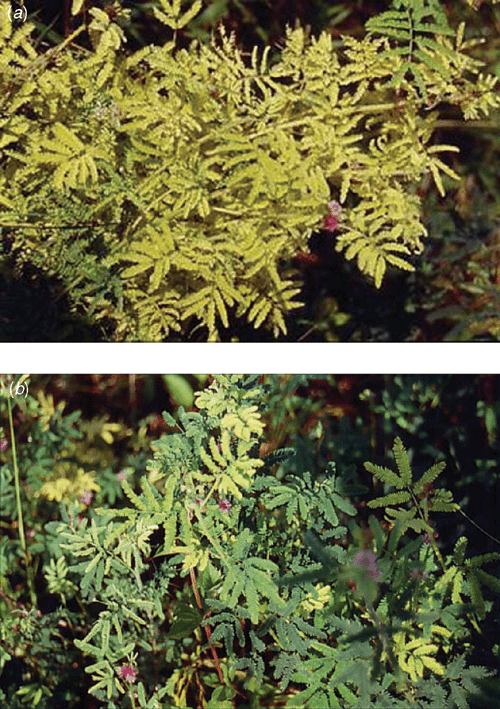First report of a whitefly-transmitted geminivirus infecting Mimosa invisa in Malaysia
M. Mahmoudieh Koravieh A , M. N. Mohamad Roff B and R. Y. Othman A C DA Unit of Genetics and Molecular Biology, Institute of Biological Sciences, Faculty of Science, University of Malaya, Kuala Lumpur 50603, Malaysia.
B Horticulture Research Center, MARDI Headquarters, PO Box 12301, GPO, Kuala Lumpur 50774, Malaysia.
C Centre for Research in Biotechnology for Agriculture (CEBAR), University of Malaya, Kuala Lumpur 50603, Malaysia.
D Corresponding author. Email: yasmin@um.edu.my
Australasian Plant Disease Notes 3(1) 25-26 https://doi.org/10.1071/DN08011
Submitted: 20 January 2008 Accepted: 17 March 2008 Published: 4 April 2008
Abstract
A begomovirus was detected by enzyme-linked immunosorbent assay (ELISA) and polymerase chain reaction (PCR) in the weed Mimosa invisa, collected from vegetable- and fruit-growing areas of the Malaysia Peninsula. The infected plants displayed yellowing and stunting symptoms. Sequencing of the 1.3-kb PCR amplicon showed that this virus has greatest sequence similarity (92%) to Ageratum yellow vein china virus, a white-fly transmitted begomovirus not yet identified in Malaysia. This is the first report of a begomovirus infection in the potential weedy reservoir, M. invisa.
Mimosa invisa is a common weed found in most vegetable-growing areas in Malaysia. During a survey of whitefly-transmitted geminiviruses, M. invisa plants showing yellowing and stunting symptoms (Fig. 1a) were collected from two farms growing either papaya and/or vegetables. Figure 1b shows an uninfected M. invisa plant. Although M. invisa plants occupied less than 5% of the total crop growing areas in the two farms they could potentially act as virus reservoirs.

|
The begomovirus positive diagnosis on two plant samples from each location was confirmed by triple antibody sandwich enzyme-linked immunosorbent assay (TAS-ELISA) using antibodies specific to Tomato yellow leaf curl virus (TYLCV, Adgen, United Kingdom). Polymerase chain reaction (PCR), using degenerate primers, was then used to further characterise the virus. This approach has been shown to be very useful for uncovering potentially new infections of begomoviruses. DNA from the M. invisa leaves from the same samples as above was extracted using a DNeasy Plant Mini Kit (Qiagen, UK) according to the manufacturer’s instructions. PCR was performed using a begomovirus-specific degenerate primer pair PAV1v722 and PAC1c1960, which is predicted to anneal within the coat protein (CP) open reading frame and the AC1 open reading frame encoding the replicon associated proteins, respectively (Muniyappa et al. 2000). All samples produced viral DNA amplicons of ~1.3 kb, which incorporated part of the CP and AC1 open reading frames and the entire open reading frames of proteins AC2 and AC3. Viral DNA amplicons were cloned into a pGEMT easy vector system II (Promega, USA) according to the manufacturer’s instructions and sequenced. Nucleotide sequences of the DNA amplicons were compared with all published nucleotide sequences from the GenBank database using BLAST analysis (Altschul et al. 1997).
Comparison of the 1.3-kb cloned sequences from each virus isolate, showed a 92% nucleotide sequence identity with that of Ageratum yellow vein china virus DNA-A (AYVCNV, GenBank Accession number AJ558120). This, as well as its cross reactivity by TAS-ELISA to TYLCV, suggests that the virus infecting M. invisa may be a whitefly-transmitted begomovirus. This is the first record of the occurrence of a begomovirus infecting M. invisa in Malaysia. Interestingly the sequence had only 86% identity to a recently described virus infecting Mimosa plants (species unknown) in Vietnam (Ha et al. 2008). AYVCNV has been reported only in China (http://gemini.biosci.arizona.edu/viruses/ayvcnv) with no previous record in Malaysia and was not found in the current survey in horticultural crops. Further surveys of M. invisa from two different locations (West and Central Peninsula Malaysia) identified plants with the same symptoms. DNA sequencing over the region amplified with the same PCR primers described above reaffirmed the suggested identity of the virus as a white-fly transmitted begomovirus with highest similarity to AYVCNV. Current studies are focusing on the sequence characterisation of the whole genome of the virus as well as extended surveys on its distribution throughout Malaysia.
Altschul SF,
Madden TL,
Schäffer AA,
Zhang J,
Zhang Z,
Miller W, Lipman DJ
(1997) Gapped BLAST and PSI-BLAST: a new generation of protein database search programs. Nucleic Acids Research 25, 3389–3402.
| Crossref | GoogleScholarGoogle Scholar | PubMed |

Ha C,
Coombs S,
Revill P,
Harding R,
Vu M, Dale J
(2008) Molecular characterization of begomoviruses and DNA satellites from Vietnam: additional evidence that the New World geminiviruses were present in the Old World prior to continental separation. Journal of General Virology 89, 312–326.
| Crossref | GoogleScholarGoogle Scholar | PubMed |

Muniyappa V,
Venkatesh HM,
Ramappa HK,
Kulkarni RS,
Zeidan M,
Tarba CY,
Ghanim M, Czosnek H
(2000) Tomato leaf curl virus from Bangalore (ToLCV) isolates, detection in plants and insects, and vector relationships. Archives of Virology 145, 1583–1598.
| Crossref | GoogleScholarGoogle Scholar | PubMed |



